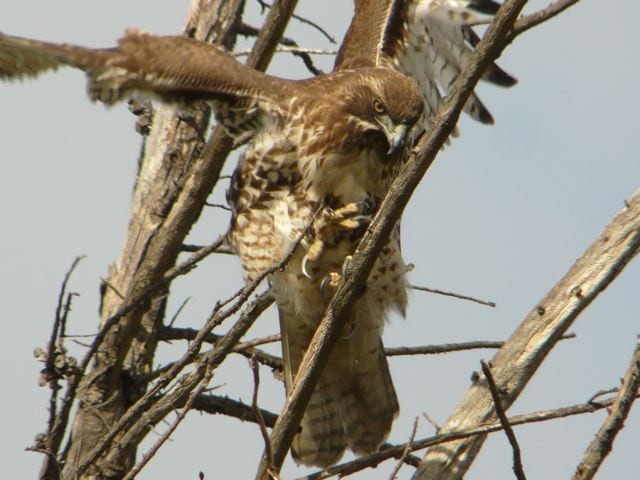
By Murray Schneider
November 13th proved warm enough to slip on a simple sweatshirt, and the nearly 50 bird lovers who gathered behind the Glen Canyon Recreation Center, ready to begin a two-hour Islais Creek bird watching outing, had earlier outfitted themselves in cotton, flannel and fleece.
Allan Ridley, the expedition leader, donned a wide-brimmed bush hat and wore a cotton shirt beneath a khaki vest that wouldn’t have seemed out of place if he’d been hired to model for an Audubon magazine photo spread.
With binoculars hanging from his neck and a high-powered telescope at his side, Ridley, who has been birding since he was twelve and who is still on the sunny side of 80, looked every inch the proverbial birder, signaling he was more than ready to sight the first winged inhabitant of the morning.
He didn’t have to wait very long.
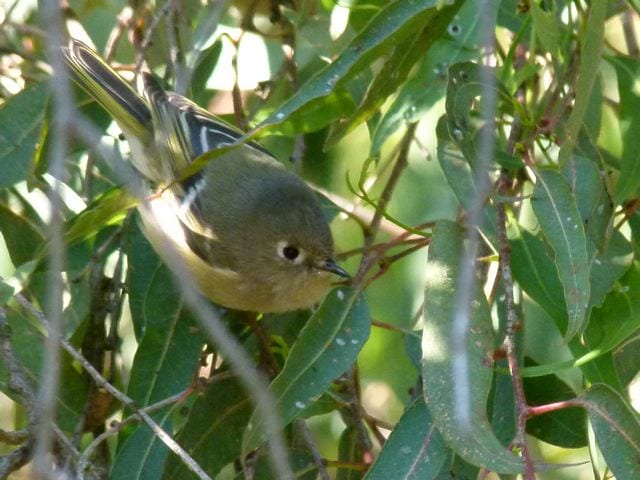
“There’s a Ruby-crowned Kinglet,” he said, pointing to a cypress tree on the canyon’s west side.
The bird watchers raised their binoculars in tandem, zeroing in on a tiny, nervous and greenish-gray bird that is often seen in the canyon willow thickets and eucalyptus trees.
The same might be said for any of the 110 or so native and migratory birds that make 70-acre Glen Canyon their sanctuary. Each nests in trees that line the creek or like the statuesque Cooper’s Hawk fashions hillside fortresses where it waits for prey that very well may include a Ruby-crowned Kinglet.
Canyon birds mix and match habitat. They use canyon willow, redwood, oak, and cypress trees for cover and camouflage, for finding food, and because of Islais Creek’s diverse riparian environs, for bathing water.
While still on the same path where the kinglet perched, Ridley directed the group’s attention to a towering eucalyptus tree, a quilted pyramid of snapped twigs and broken limbs crowning its highest reaches.
“That’s a nicely constructed, multi-year nest,” he said. “Could belong to a Red-tailed Hawk.”

Accompanied by his wife, Helen McKenna, Ridley is no stranger at leading battalions of bird watchers. For decades he and McKenna, a retired Wallenberg High School principal, have been educating birders on the first Sunday of each month at the Botanical Gardens in Golden Gate Park.
“There’s the kinglet hopping in the cypress,” McKenna said, as she elevated her field glasses and pointed to the fledgling.
“The smaller the birds,” said Ridley, with professorial nonchalance, “the more excited they get.”
The diminutive bird’s agitation may very well have had something to do with a razor-beaked raptor concealed in foliage, waiting in ambush across the creek.
“Birds sing songs to warn one another of predators,” said Ridley.
Ridley, slim and wiry and with a patrician’s air, spoke in mellifluous tones, which seemed curiously more softened by his militarily clipped mustache. Until his retirement, not surprisingly, he taught high school biology at Urban High School.
Now, two weeks into November, he and McKenna scheduled a busman’s holiday at the behest of Richard Craib, president of the 130-member Friends of Glen Canyon Park, which sponsored the Sunday bird viewing.
Ridley signaled the group to continue along Banana Slug Way, which parallels Alms Road, the main canyon service road that is wide enough to accommodate fire trucks.
“Would the last person please grab the telescope,” he called from the front of the bunched-up walkers.
McKenna appraised the trailing throng, stopped and pointed east.
Ridley raised his glasses. “A White-crowned Sparrow,” he said, identifying a nestling with a smart black- white head and combined with its crisp gray breast gave it a dashing look, not unlike Ridley’s own natty appearance. “They’re migrants, flying in from Washington, Oregon, even British Columbia and Alaska.”
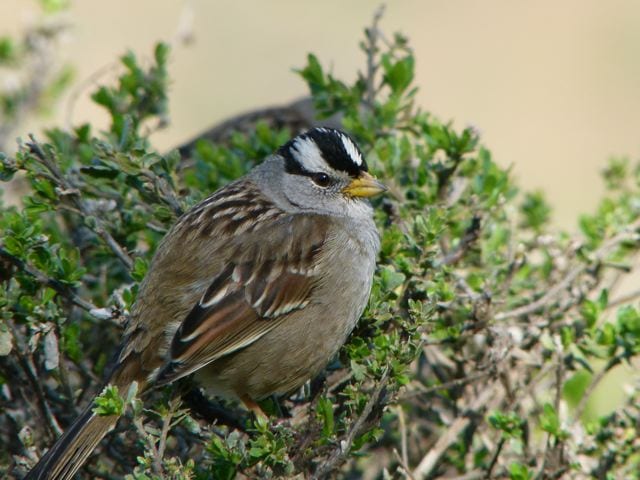
This species of sparrow is commonly ensconced in canyon willow, serenading canyon visitors from its haven while performing its daily ablutions. “Willow is great habitat for birds because it harbors lots of bugs,” McKenna said. “It’s like a cafeteria.”
She sighted a willow perching House finch, then gestured to a black and white Dark-eyed Junco resting in an elderberry tree. “He’s been bathing,” she observed. “Birds get lots of parasites and they need to wash.”
The group continued on, crossing the creek at Silver Tree Day Camp. They trooped across the boardwalk, marching north, alert for additional avian sightings. “This is a great bird introduction, said Ridley, sounding every bit like the motivational instructor he once was.
McKenna, his team-teaching partner, piped in: “Birds like to sleep so when you see lots of mid-day butterflies, you can count on the birds napping.”
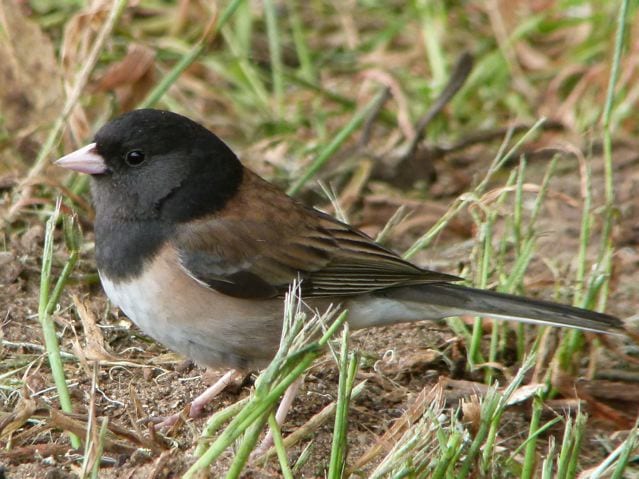
In the lead, Ridley stopped, pointing high into a canopy. “It’s a Townshend’s Warbler,” he said, jabbing a finger toward a bird with a distinctively etched face, its raccoon markings giving it away.
The two-hour trip now nearly over, the group angled toward a chert rock formation, a popular theater for rock climbers. McKenna looked at her watch, nudging Ridley.
A young man gained Ridley’s attention. He pointed to a bushy Coast-live oak that stood on the grassland several yards from the craggy rocks. Ridley moved his telescope, tapping at its tripod, positioning it toward where the young man pointed.
He peered through the lens, then announced, “A Cooper’s Hawk.”
Watchers raised their binoculars while others lined up behind Ridley’s scope, waiting their turns to bring the raptor up close and personal.
The Cooper’s Hawk, all 20 inches of it, with a wing span 25 inches, is a swift, agile and cunning predator found in natural forested areas, even those incongruously located in the center of San Francisco. With its small wingspan and tiny beak, its powerful feet and talons, the Cooper’s Hawk is adept at grasping prey such as a songbird, eviscerating and consuming it in a matter of minutes. Arbors are neither a deterrent nor an impediment when these raptors hunt since they can maneuver through trees limbs and branches in the manner of a football punt returner threading his way though a defensive alignment.
“The Cooper’s Hawk’s smaller wing span,” said McKenna, “makes it easier to navigate willow.” Nearly hidden by a cloak of oak leaves, the hawk stared out with imperious gravitas, studying the horizon, its laser-sharp eyes alight and its lithe neck torquing. One after another, with Ridley standing generously aside, the birdwatchers took turns at his telescope.

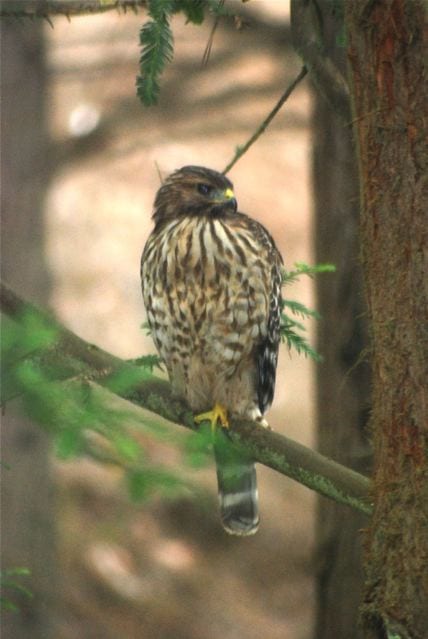
The accipiter sailed in a current of wings, moving fast. It knifed toward a copse of willows, but then did an about face and glided to the precipitous rock outcropping. “It may have gone for the White-crowned Sparrow,” said Ridley.
Unsuccessful in its hunt, the hawk skimmed past the oak and then out of view, its needle sharp claws coming up empty. The birdwatchers took in a collective breath and began peeling off, strolling back toward their morning rendezvous in groups of twos and threes.
Ridley lagged behind, answering last minute questions while McKenna offered an opinion or two on the prosaic subject of dogs and their impact on aggregate bird populations, opining that the safest place in the City for birds is Golden Gate Park’s arboretum where man’s best friend is prohibited.
Above, a Red-tailed Hawk caught a thermal. It floated in figure eights, circling, looking down, scoping the terrain for a morning meal.
Anyone wishing to accompany Allan Ridley and Helen McKenna on their next bird watching excursion can meet them on the first Sunday of each month at the 9th Avenue and Irving Street entrance to the San Francisco Botanical Gardens. Please be at the gate by 7:45 A.M.